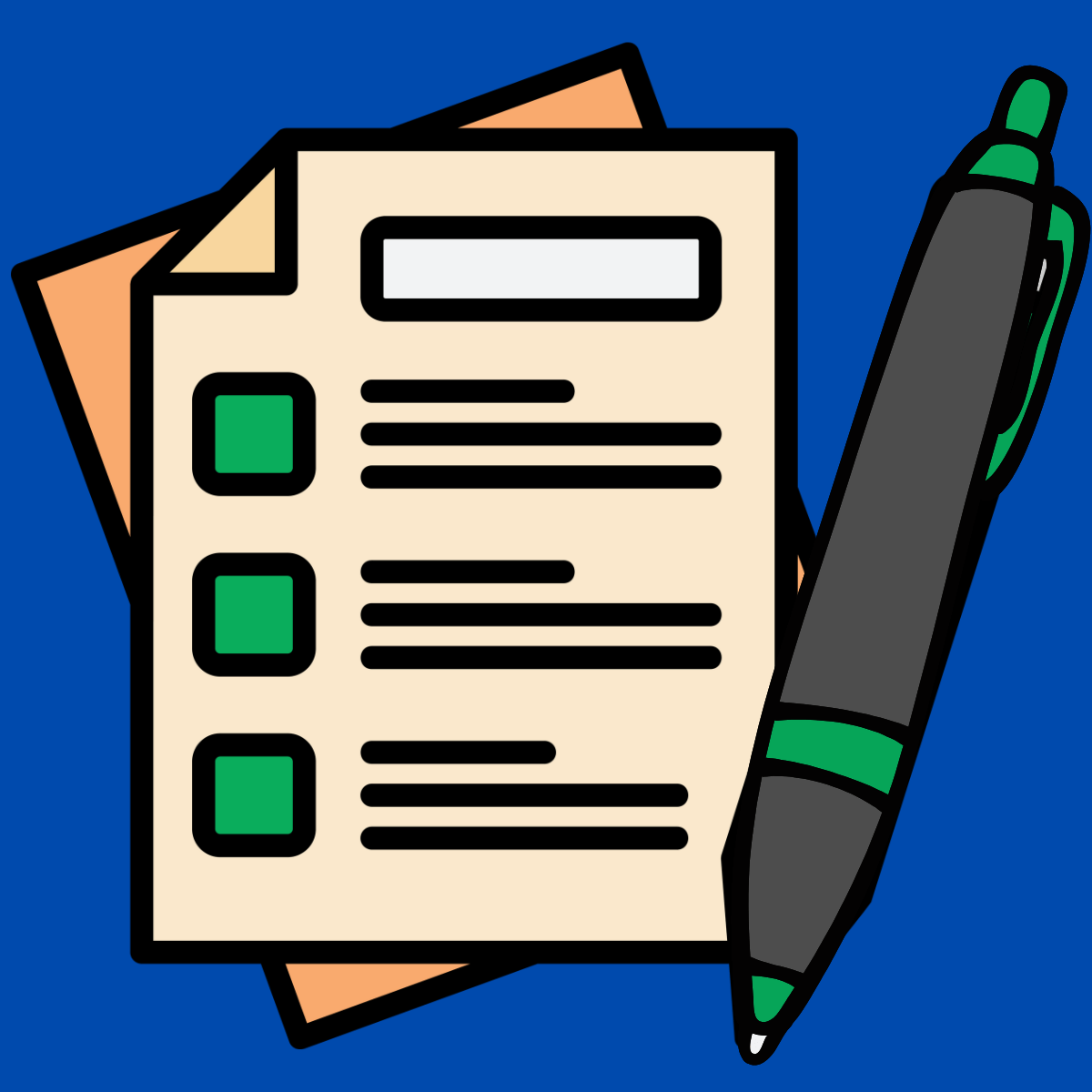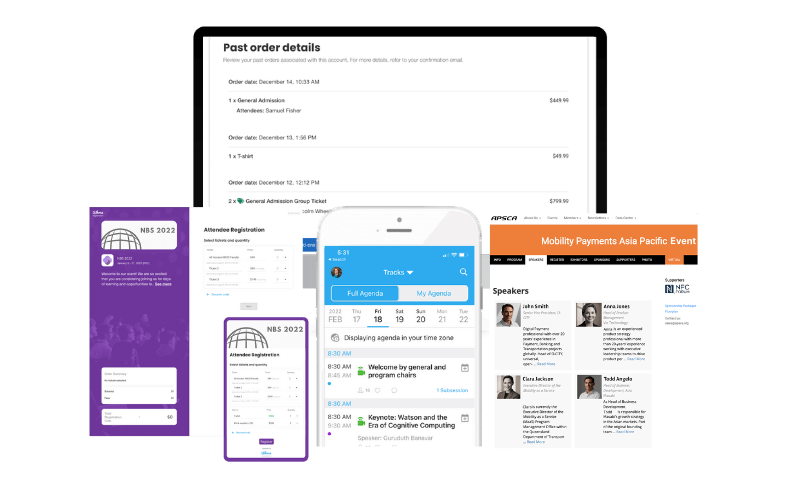Author: Whova | Last updated: June 17, 2025

Organizing a successful event is a huge undertaking that requires many moving parts. It’s nearly impossible to carry out an event without a high level of organization. That’s why it is essential to create an event planning checklist that can be shared with all members of your organization to have everyone on track and the event runs smoothly. This is where an event brief comes in handy. Looking to streamline your next event? Our free event brief template can help you stay organized, aligned and on budget – without the stress.
In this article, we’ll go over what is an event brief, the essentials of creating an event brief and a step-by-step guide for creating one. Used by industry leaders like Google, Microsoft and over 50,000+ events, Whova has crafted the perfect event brief template — 📥 Download the editable event brief template now.
What Is an Event Brief and Why Should You Create One?
An event brief is an all-encompassing guide on the planning and execution of your event. An extensive planning guide will allow you to keep track of everything in one place. It’s the best way to keep your entire team on the same page with a clear vision of what needs to be done by whom. Think of it as your single source of truth — for team alignment, external partners, and your sanity.
Even if you have only a few team members or feel like you’re short-staffed, making an event brief won’t be a waste of time. In fact, it will save you time in the long run. Typically, an event brief will contain:
- a detailed event description,
- event location
- event format (in person, virtual or hybrid)
- a list of measurable goals
- important dates and deadlines
- audience information
- staff profile
- budget table
- and more.
Be sure to check out our free event brief template to get a good start on creating your own event brief.
An event brief will help you keep track of all the details you need to consider when planning your event. A disorganized event planning process more often than not will result in a lower quality event experience for attendees and staff, and sometimes a lost opportunity to host that event again. It shouldn’t come as a surprise then, that a well-planned event can help you reach all of your goals for the event. There is no magic when it comes to planning an event. The key is all in the details. And there is no better way of keeping track of the event details than through an event brief.
What’s the Purpose of an Event Brief?
The purpose of a comprehensive event brief is to clearly outline the key event details, goals, and requirements in one concise document. It serves as a central reference point for everyone involved—organizers, vendors, and stakeholders—ensuring alignment on the event’s objectives, target audience, budget, timeline, and logistics. A strong event brief helps keep planning focused, organized, and on track from start to finish. At the end, with an effective event brief, you’ll be able to easily draft your post event report by looking back into the details.
Essential Elements of a Professional Event Brief (With Examples)
A detailed event description is the most important piece of the brief, as it will maintain an overall vision of the event. All event planning activities should revolve around this information, which is why it should typically remain close to the top of the event brief format. To an outside organization, who will want to see your event plan, a brief shows strong organization, dependability, and a clear focus. Making finding partners more likely to work with you. Some basic information to list in your event briefing document includes:
| Brief Component | Details |
| Event Title | + Include a clear title for your event and information about your organization |
| Event Description | + This should only be 3 paragraphs max |
| Event Date(s) and Time | + This should include the dates and hours your event will be live
+ If this part is not concrete, include a rough estimate of the date and hours |
| Type of Event | + Is it a conference, meeting, exposition, etc |
| Format | + Will the event take place in-person, virtually, or hybrid |
| Location and Venue | + If you haven’t secured a venue yet, you can lay out a list of possible venues
+ Make sure your list of possible venues shows whether they have been contacted or confirmed |
| Agenda/Schedule | + You should include a link to the event agenda.
+ Highlight where changes could happen since schedule changes are common and can occur at any point |
| Website | + It’s important to monitor the event website to be sure the site is up
+ Test your website and make sure and that the registration software is working smoothly |
📎 Tip: Use Whova to manage your website, badge printing, and check-in.
How to Write an Event Brief: Step-By-Step Guide
There are 10 main steps you should follow and include when creating a successful event brief. These steps will ensure you don’t leave anything out:
- Outline the purpose and goals of your event
- Keep track of key details and dates
- Know your audience
- Follow a consistent event theme
- Include budget details
- Add an income section
- Create a task checklist
- Keep tabs on partners
- Compose your speaker wishlist
- Know your event staff
Now, lets go over each step in more detail.
1. Outline the Purpose and Goal(s) 📝
Every event has an overall purpose or a set of purposes, and you should be clear on what they are. It’s crucial to have them in writing so each team member is aware of why the event is being run.
Once your purpose is established, you can start setting concrete goals for the event. Each goal should fit within the SMART framework: Specific, Measurable, Achievable, Realistic, and Time-based. Some examples include making X-amount of profit by the end of the event, having X number of registrations by the start of the event, or an X% increase in members 1 month after the event.
2. Keep Track of Important Deadlines and Dates 📅
It’s necessary to make a clear note of important dates before and during your event, such as when set up begins, registration time frame (which may vary depending on the type of event registration platform), speaker rehearsal dates, etc. This will help you stay on track and be cross-referenced with the checklist.
3. Know Your Audience 👥
Include an outline of your event’s attendee demographic. It’s important to establish a clear understanding of your audience to ensure the event will be well-catered to them specifically. You can use that data to guide your marketing efforts.
This information can also help you choose the event theme, content, activities, and the most suitable event registration platform that caters to your target audience’s needs and preferences.
You’ll want to list: Total # of attendees expected (overestimate to be safe), attendee’s professions, education, background, and any other pertinent demographic information (age, gender, etc.)
4. Follow a Consistent Event Theme 🎯
You’ll want your event to follow a central theme to ensure it brings a cohesive and memorable experience for attendees. Keep in mind that everything purchased and designed should be in accordance with the theme. Make sure your theme is clear on the following: Branding, Colors, Topic, Layout, and Marketing Plan.
5. Include Budget Details 💲
The event budget is an extremely critical part of your event brief. To avoid overspending, start by setting a strict maximum spending limit. From there, you will need to list out every item and its estimated cost, no matter how small. Once it’s been purchased, be sure to update the budget sheet with the actual cost.
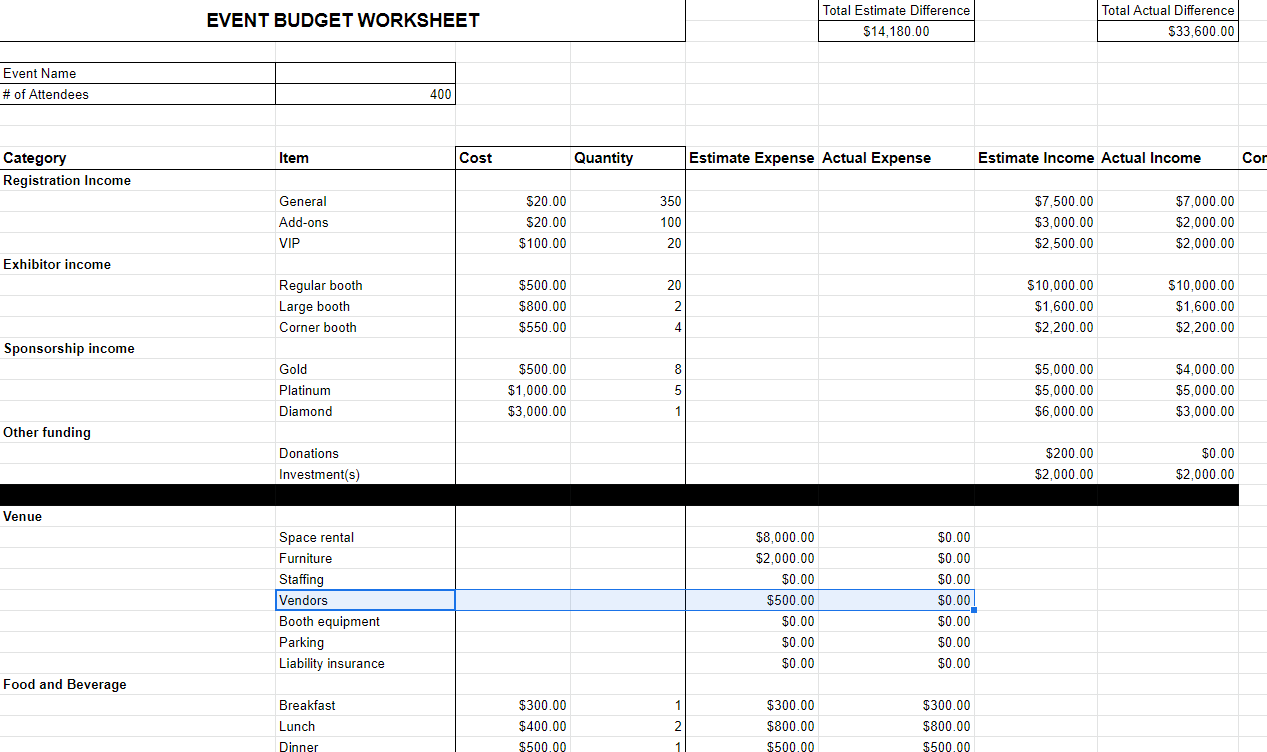
Whova’s free event budget template can be customized to fit your event
Diligently tracking the budget will ensure the total costs are less than the maximum spend limit. You may also break your budget up into different item categories, like catering, print materials, A/V equipment, led light installations, venue, staff/security, and more. Since budget information should be very detailed, it can be created in a separate spreadsheet that should still be shared with other organizers and team members.
6. Add an Income Section 💰
Creating an income section will help set up the event budget. Here, you can list out each source of revenue you expect to earn, such as merchandise and sponsorships with the expected and actual earned amounts. Once you have a total, you can use it for your goals and/or budget.
✅ Template Tip: Use our free event budget template to map your event goals and revenue projections.
7. Create a Task Checklist ☑️
Having a comprehensive checklist for every planning task is essential to be confident that nothing was overlooked or forgotten before the event. You can also list the due date and status of each task. Organizers and staff can update them to ensure no task is done twice and time is not being wasted. Having a central event project management tool such as Whova can handle various event logistics while keeping track of the progress.
8. Keep Tabs on Partners 📞
You’ll want to have a list of all of your event partners(A/V company, event management platform, sponsors, exhibitors, and/or any other external organizations involved with your event.) Losing their contact details can cause errors that could have been avoided with attentive communication. Make sure that all participating parties are on the same page.
9. Compose Your Speaker Wishlist 🎤
Securing great speakers for each session of the event can be difficult, so make sure you have backup options and know the status with each of them. You’ll want to list their contact information and whether they have been contacted or confirmed.
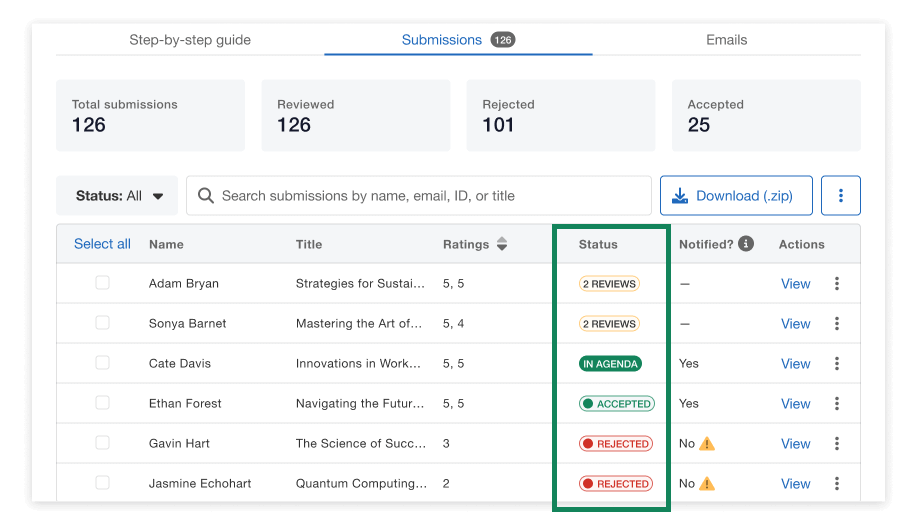
Easily attract, review, and manage potential speakers with Whova’s abstract management software
10. Know Your Staff 💬
It can be difficult to keep track of each staff member and efficiently delegate everyone’s roles and responsibilities. It will be beneficial to include their name with their role and contact information. Not only does this allow you to see who is involved with what part of the event, but it can also save you time from having to scramble to try to contact a certain staff member. You can share it with the whole event coordination team to make collaboration smoother.
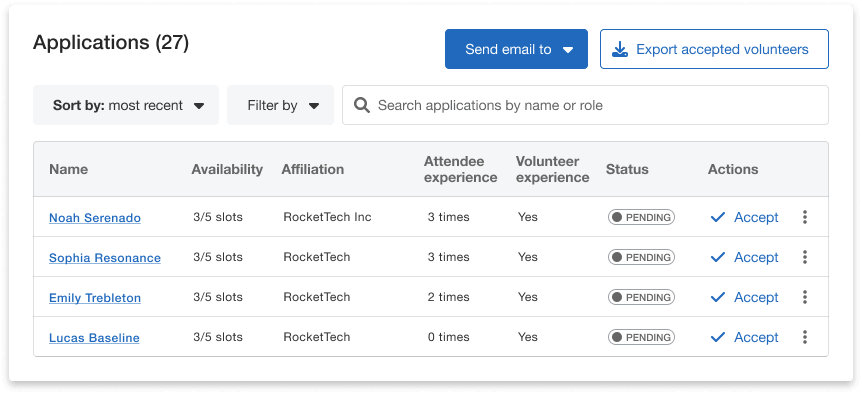
Find volunteers and keep track of their application and contact information all in one place with Whova
Bonus Section – How AI Tools Can Save You Hours on Event Brief Creation
AI tools are becoming increasingly popular for event project managers and organizers to use while planning events. AI can even help you create an event brief by writing and organizing content quickly.
Specifically, AI can support event organizers in writing an event brief by generating structured, clear, and concise content that outlines the event’s objectives, schedule, target audience, and logistics.
When using AI, make sure you clearly outline what you want from it and the type of event you are having.
Pro Tip: If you want help creating specific and clear AI prompts for creating an event brief download our free guide: 5 AI Prompts to Help Auto-Generate Event Briefs
Download 5 AI Prompts to Help Auto-Generate Event Briefs
Otherwise, here are some other good sample prompts that clearly outline what the user is looking for and event details:
Prompt 1 – Corporate Sustainability Event: “Go over some key things to include for a 100 person virtual HR conference event brief focused on networking.”
Prompt 2- Charity Gala: “Create an event brief outline for a 5,000 person charity gala targeting $20,000 in donations with an emphasis on guest engagement and fundraising targets.”
AI tools can also suggest ways to emphasize key event goals, sponsor highlights, and potential challenges. AI allows organizers to save time while maintaining professionalism and clarity. Some event management platforms like Whova support AI-assisted brief building directly inside their platform.
Learn more about how AI can help your event planning.
Next Steps: Download Your Event Brief Template and Start Planning
🎉 Grab Your Free Event Brief Template Now. Now that you know what an event brief is, ways it can be used and how to create one, start making yours today by downloading our popular free event brief template! Whova has been used for 50,000+ events by organizations like NASA, US Bank, and Stanford, and we used our expertise to make sure the template is complete, detailed and helpful.
With an event brief, you can keep track of all the information you need and be more comfortable leading up to the event, making your event more successful!
FAQs
What is an event brief?
An event brief is a short, structured document that outlines the essential details about an upcoming event. It serves as a guide for everyone involved, ensuring clarity on the event’s purpose, goals, logistics, and expectations.
How do I write an event brief?
To write a comprehensive event brief, begin by clearly stating the event’s objective and target audience. Then include key details such as the event name, date, time, location, budget, and key stakeholders. Be concise but thorough, covering all critical elements that will guide the event planning process and execution.
What is included in an event planning brief?
An event planning brief usually includes the event’s purpose, goals, target audience, date and time, venue details, budget, schedule or agenda, logistics (like catering and AV needs), marketing plans, and contact information for key team members and vendors.

